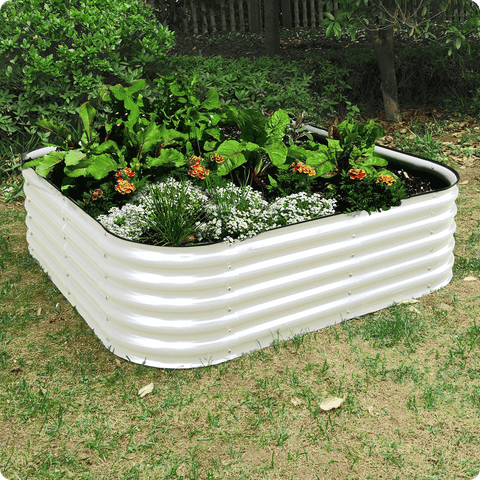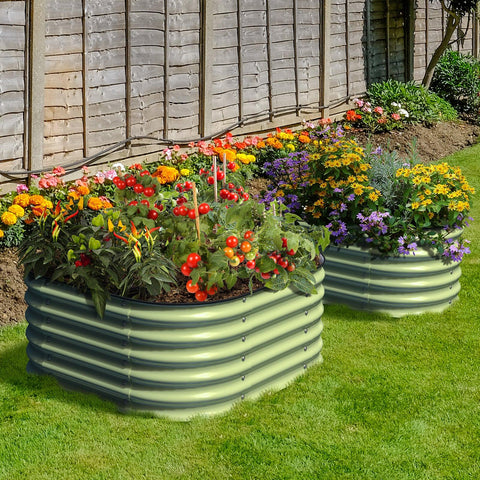Tips from Olle Garden Bed: 5 Ways to Use Autumn Leaves in Gardens
There is nothing like the fresh air in autumn to make you feel like gardening in autumn. As the leaves begin to turn yellow and red, it's time to use your creativity and come up with interesting ways to use all these gorgeous leaves! Don't let the beautiful leaves go to waste. The following content also has some reference value for raised garden beds.
There are many ways to use them in your garden. Whether you want to add some autumn style or help compost, fallen leaves are a valuable resource. So go outside and start collecting!

Wildlife habitat
One of the best things about using autumn leaves in gardens is that they provide a habitat for a variety of wild animals. Pollinators such as bees and butterflies, as well as small insects such as snails, moths and spiders, will use fallen leaves to escape the cold weather.
Insects also winter in the leaves, which can provide food for birds in spring. Fallen leaves are a good home for creepy climbers!
Cover
Deciduous leaves are an important source of cover for your garden. They help keep the soil moist and help prevent weeds from growing. They also add nutrients to the soil as they decompose.
If you have many trees in your yard, collect leaves and use them as mulch. If you don't have trees, ask your neighbor if they do.
You can chop up the leaves before using them as mulch, or you can chop them up and put them in the garden. Both will decompose, but you may encounter problems with uncrushed leaf mats and may suffocate your plants.
Spread leaves around plants in winter. This will add nutrients to them and keep the soil warm.
Leaf mold
Leaf mold is a good way to add organic matter to the soil, improve drainage and help prevent compaction. Leaves also provide a good source of food for worms and other beneficial organisms.
Here are some tips on how to use autumn leaves in your garden:
Collect leaves from your yard or nearby. Avoid using leaves treated with pesticides or herbicides.
Use a lawn mower or blade blower to cut the leaves into pieces or whole pieces. However, chopping leaves will help them decompose faster.
Rake the chopped leaves into a pile and keep them moist. This will help mold spread faster.
Etc. This process is progressing very slowly. This may take one to three years, depending on weather conditions.
Once the leaves break down, you leave behind a black, sweet soil conditioner rich in magnesium and calcium. You can now add them to your vegetables or garden!
Leaf mold or leaf compost is different from ordinary compost because it does not contain so much nutrients, but it still provides many benefits. It will not get hot or need to rotate.
Flaky covering
If you plan to garden in the spring of the future, fallen leaves can help you prepare the soil and promote growth.
Autumn leaves are rich in nutrients beneficial to plants, including nitrogen, phosphorus and potassium. When they decompose, they release these nutrients into the soil so that they can be used by your plants.
Leaves also help improve the structure of the soil. When they decompose, they add organic matter to the soil, which helps improve drainage and aeration. This is particularly beneficial in clays, which can be heavy and dense.
The best time to cover autumn leaves is in late autumn or early winter. This gives them time to break down and release nutrients into the soil before the growing season begins.
If you have many leaves, you can cut them up with a lawn mower or a mulcher. This will help them decompose faster. Then put some cardboard or burlap on the grass, and spread 6 inch leaves on the future garden bed.
Paperboard or burlap and leaves will decompose, just like the grass below. This will provide essential nutrients for your plants and improve the structure of the soil.

Have fun with them!
Autumn leaves are a good way to add fun and excitement to your home! You can create natural decorations by stringing leaves on fishing lines or hemp ropes. You can hang them on the eaves of the porch, drape them on the door or window, and even use them as business cards for the autumn themed dinner.
Autumn leaves can also do a lot of outdoor activities. You can jump in, rake them into a pile, then jump in again, or even just lie down and relax.
You can even take your family to a leaf treasure hunt to see how many different colors and types of leaves can be found.
Summary
Have you ever tried using leaves in your garden? If not, it's time to be creative! Leaves can be a valuable resource to add color and texture to your autumn garden. Not to mention, they can help compost. So go out and start collecting!
